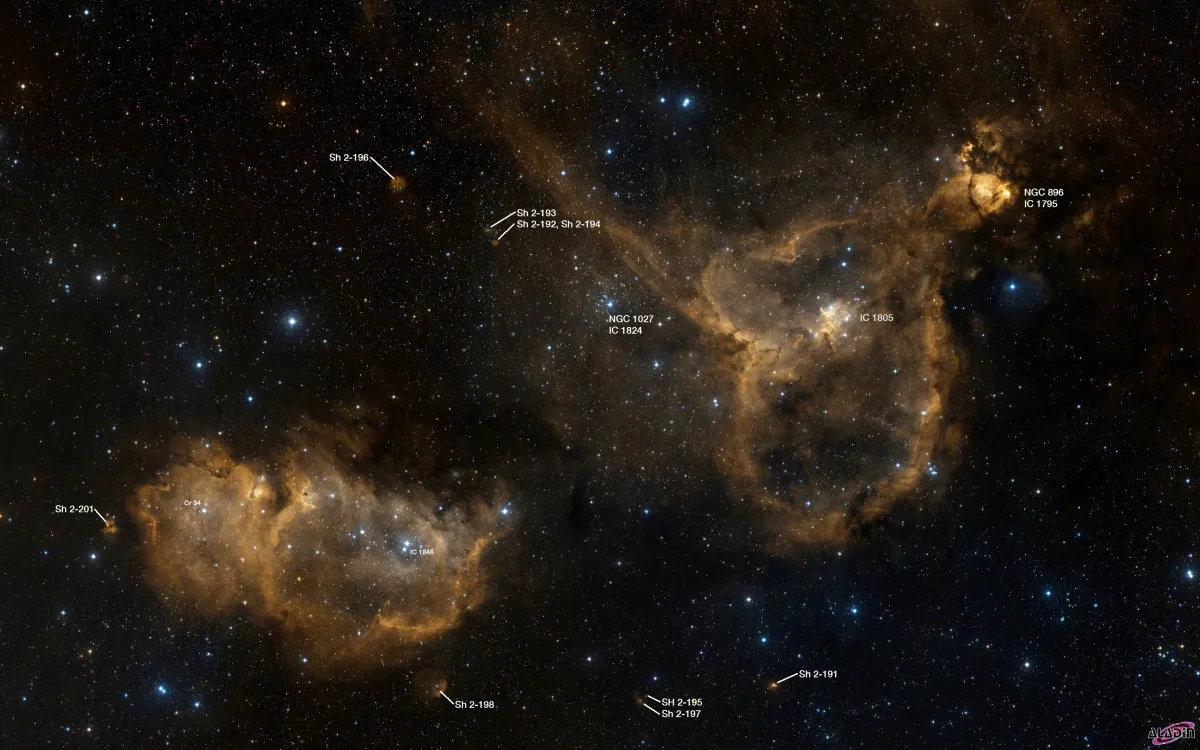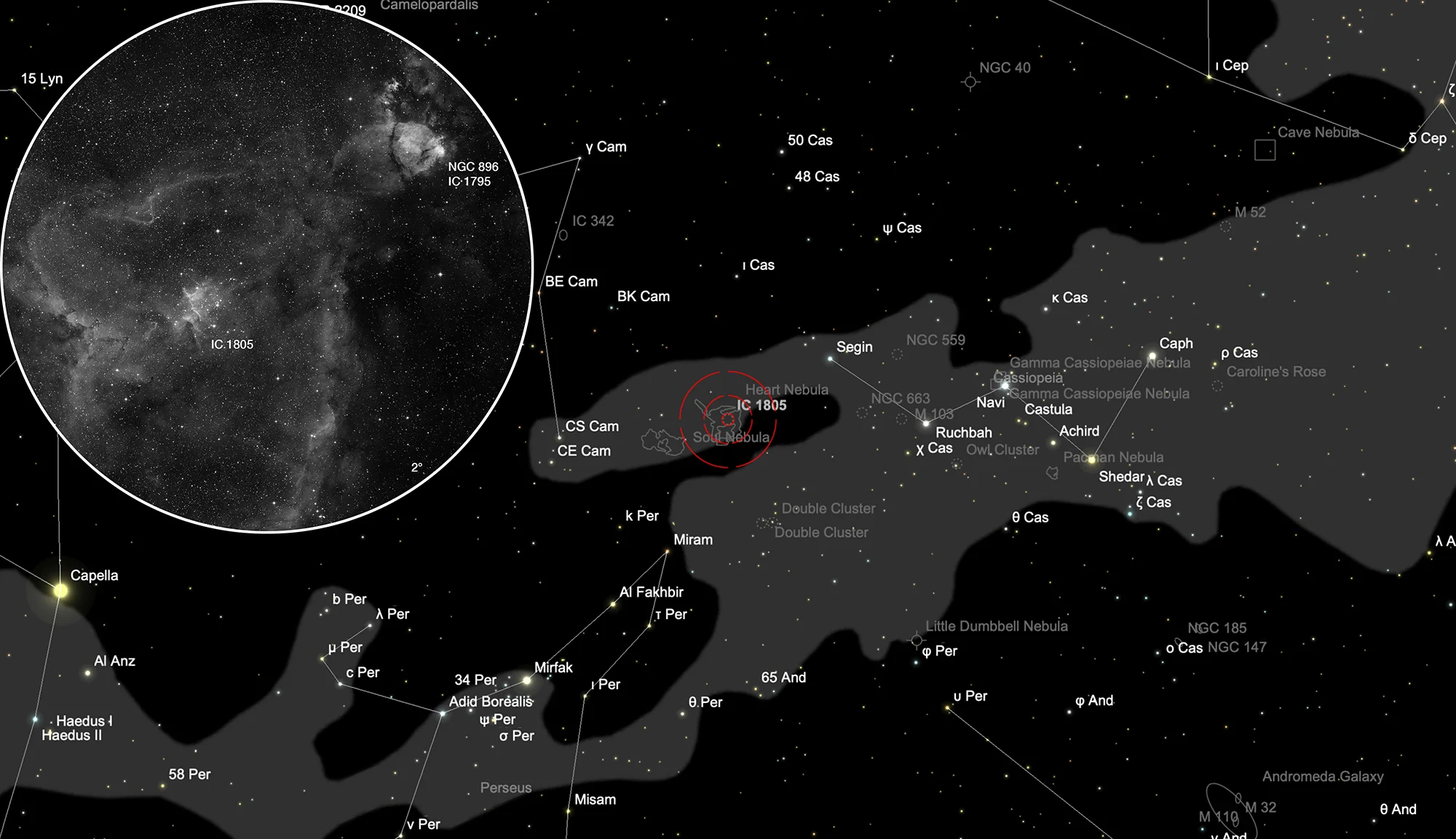Heart Nebula (IC 1805)




History
On 3 November 1787, the German-British astronomer William Herschel discovered a «very faint nebula» which he cataloged as WH III 695 and described as: «extremely faint, pretty large, of irregular figure.» [464] John L. E. Dreyer included it in 1888 as NGC 896 in his «New General Catalogue of Nebulae and Clusters of Stars». [313]
In 1890 the American astronomer Edward Barnard photographed the same section of the sky and discovered a «foggy spot» a little northeast at the location noted for NGC 896, which John L. E. Dreyer unwittingly included in his second «Index Catalogue» as IC 1795 as a double entry for NGC 896. Presumably Herschel only saw the brightest western part of IC 1795. About one degree southeast of this nebula Barnard discovered another large nebula in which an open star cluster was embedded. This then became IC 1805. [196]
In 1915 British astronomer Philibert Jacques Melotte published a catalogue of Star Clusters shown on Franklin-Adams Chart Plates, a photographic star atlas prepared by John Franklin-Adams and published in 1914. The catalogue contains 245 clusters and IC 1805 is listed there as number 15, hence the designation Mel 15 (or Melotte 15). He gave a diameter of 15 arcminutes and noted: «A very loose cluster. Somewhat similar to NGC 1027, but stars not so numerous and generally brighter.» [158]

In 1931 Swedish astronomer Per Collinder listed IC 1805 as cluster nr. 26 (Collinder 26) [455]
In 1946 Swedish astronomer Sven Cederblad published his «Studies of bright diffuse galactic nebulae with special regard to their spatial distribution» and included the nebulosity IC 1795 as Cederblad 6 and noted: «The nebula apparently consists of three parts: 6a = +61 411 with a fan-shaped appendix; 6b = A thirteenth mag. star with ditto; 6c = General background veil.» The nebula IC 1805 is there listed as Cederblad 7 and noted: «R. Nebulous cluster containing the BD stars: [...]. The spectra of these stars are stated to be "perhaps B0". There is a conspicuous condensation at [BD] +60 507.» [130]
In 1959 the American astronomer Stewart Sharpless included the nebula around cluster IC 1805 as Sh 2-190 in his famous «Catalogue of H-II Regions». His catalogue covers 313 H-II regions identified on the photo plates of the «Palomar Observatory Sky Survey» down to a declination of -27°. [310]
Physical Properties
All objects (NGC 896, IC 1795 and IC 1805) are connected to one another, large H-II area and form the «Heart Nebula», which is formed by the young O and B stars in the star cluster in IC 1805 (Collinder 26, Melotte 15) can be excited to glow. On Simbad a distance of 4.1 kpc (13'400 light years) is found for IC 1795. For IC 1805 one finds distances of 1.7 kpc to 6.1 kpc (around 5500 to 20'000 light years). The real distance is probably somewhere in between. [145]
| Name | RA | Dec | Type | vMag | Dim | MD | Dreyer Description | Identification, Remarks |
|---|---|---|---|---|---|---|---|---|
| NGC 896 | 02 25 27.8 | +62 01 10 | EN | 10 × 10 | 2.300 | eF, pL, iF | WH III 695; GC 531; IC 1795; LBN 645; CED 6; SG 1.04; Min 2-57; narrrow dark lane n-s, SNR ? | |
| NGC 1027 | 02 42 36.0 | +61 35 42 | OCL (III2p) | 6.7 | 15 | 0.772 | Cl, L, sc st, one 10 m | WH VIII 66; GC 578; IC 1824; OCL 357 |
| IC 1795 | 02 25 27.8 | +62 01 10 | dup | 10 × 10 | 2.300 | Patch of neby | NGC 896; LBN 645; CED 6; SG 1.04; Min 2-57; narrrow dark lane n-s, SNR ? | |
| IC 1805 | 02 32 48.0 | +61 27 42 | OCL (III3pn) | 6.5 | 20 | 1.886 | Cl, co, eL neby extends f | OCL 352; Mel 15; LBN 654 |
| IC 1824 | 02 42 36.0 | +61 35 42 | dup | 6.7 | 15 | 0.772 | Cl, st F, perh. F neby p extends to it | NGC 1027; OCL 357 |
Finder Chart
The Heart Nebula is located in the constellation Cassiopeia. In Central Europe it is circumpolar. The best time to observe, however, is July to March, when the constellation is highest at night. About 2.5 degrees further east is another nebula, the «Soul Nebula» (Sh 2-199 with cluster IC 1848). Both nebulae are often referred to together as the «Heart and Soul Nebula».
